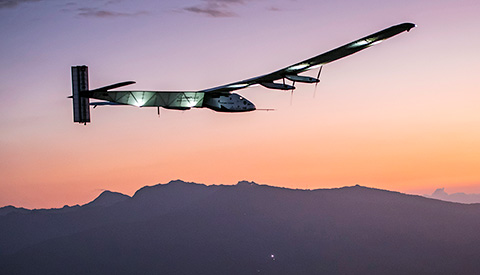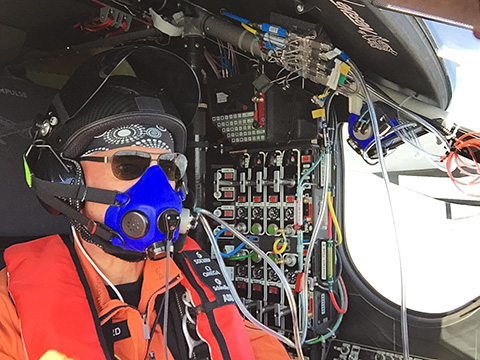
With Swiss pilot André Borschberg at the control, Solar Impulse 2 is seen arriving in Hawaii on 3 July 2005 after its record crossing from Japan and 5 days and 5 nights of continuous flight over the Pacific Ocean ! ©Solar Impulse
Hawaii, USA, 11 July 2015 – Attempting the first round the world solar flight, the airplane of Swiss explorers Bertrand Piccard and André Borschberg has broken all distance and duration world records for solar aviation (80 hours and 5,663 km) on 1st July. At the helm, André Borschberg also breaks the record for the longest solo flight ever. By remaining airborne three consecutive days and nights, producing its own power with solar energy, Solar Impulse 2 has proven that Bertrand Piccard’s vision of reaching unlimited endurance without fuel was not a crazy dream.

Bertrand Piccard and André Borschberg celebrating the incredible 3 July 2015 success of Solar Impulse 2 in Hawaii. ©Solar Impulse
By flying above the Pacific Ocean for over 80 hours, André Borschberg, co-founder, CEO and pilot of Solar Impulse, has also achieved the longest non-stop solo flight without refuelling between Nagoya (Japan) and Hawaii (USA) in terms of duration. An accomplishment exceeding the late US adventurer Steve Fossett’s flight on board Virgin Atlantic Global Flyer, who, in 2006, realized a 76 hours non-stop flight to circumnavigate the globe. “Can you imagine that a solar powered airplane without fuel can now fly longer than a jet plane!”, said Bertrand Piccard, initiator, chairman and alternate pilot of Solar Impulse. “This is a clear message that clean technologies can achieve impossible goals!”

For the long duration flights at high altitude on Solar Impulse 2, Bertrand Piccard and André Borschberg have to rely on a regular supply of oxygen, thus adding to the difficulty of their round the world flight. ©Solar Impulse
André Borschberg has endured true human, technical and operational challenges, navigating the high tech flying laboratory alone in an unheated and unpressurized 3,8 cubic meter cockpit. “The first 24 hours were very technical”, said André Borschberg, “but the second day was really getting me into the mission. It took me a while to create a relationship of trust with the airplane, which allows me to rest and eventually sleep by periods of 20 minutes with the autopilot. The experience of flight is so intense that I can only focus on the present moment and discover how to deal with my own energy and mindset.”
Bertrand is now set to continue later during August this epic ocean crossing to Phoenix, Arizona. The journey will then take the two pilots, flying alternatively in the single seater cockpit, across the USA, the Atlantic Ocean and back to Abu Dhabi where the journey started on 9 March last.

Solar Impulse 2 has a take-off mass of 2,000 kg. It is however a very big aircraft 21.85 m long and with a wingspan of 63.4 m. The huge wing contains 11,628 photovoltaic cells rated at 45 kW peak: 200 m2 (2,200 sq ft). They provide energy for the four electric motors providing 7.5 kW (10 HP) each. ©Solar Impulse
Despite having completed the longest and most difficult leg of the Round the World Solar Flight, the solar powered airplane of Bertrand Piccard and André Borschberg has suffered battery damages due to overheating. During the first ascend on day one of the flight from Nagoya to Hawaii, the battery temperature increased too much due to over insulation. And while the Mission Team was monitoring this very closely from Monte Carlo during the mission leg, there was no way to decrease the temperature for the remaining duration of the flight as each daily cycle requires an ascend to 28’000 feet and descend for energy management issues. The damage to certain parts of the batteries is irreversible and will require repairs and replacements that will take several weeks to work through. In parallel at this time, the Solar Impulse engineering team is looking at various options to better manage the cooling and heating process for very long flights. Thus Solar Impulse does not see the possibility for any flights before 2 to 3 weeks at the earliest.
By Leandro Maldonado
